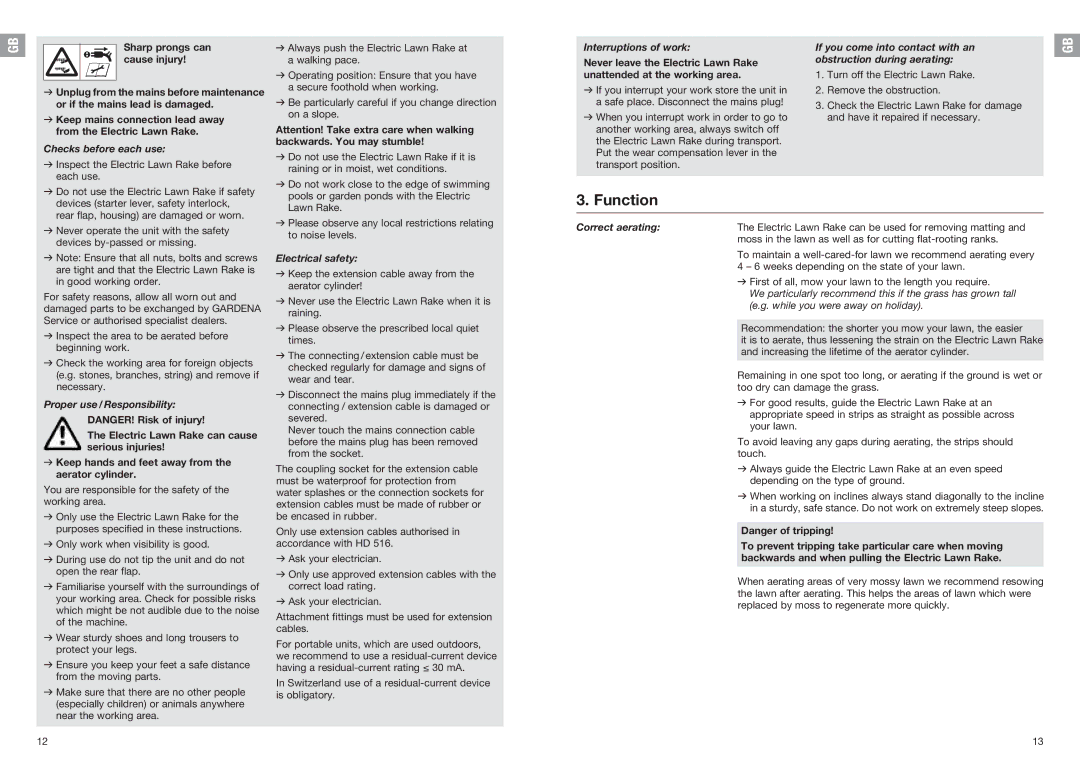
GB
Sharp prongs can cause injury!
vUnplug from the mains before maintenance
or if the mains lead is damaged .
vKeep mains connection lead away from the Electric Lawn Rake.
Checks before each use:
vInspect the Electric Lawn Rake before each use.
vDo not use the Electric Lawn Rake if safety devices (starter lever, safety interlock, rear flap, housing) are damaged or worn.
vNever operate the unit with the safety devices
vNote: Ensure that all nuts, bolts and screws are tight and that the Electric Lawn Rake is
in good working order.
For safety reasons, allow all worn out and damaged parts to be exchanged by GARDENA Service or authorised specialist dealers.
vInspect the area to be aerated before
beginning work.
vCheck the working area for foreign objects (e.g. stones, branches, string) and remove if necessary.
Proper use / Responsibility:
DANGER! Risk of injury!
The Electric Lawn Rake can cause serious injuries!
vKeep hands and feet away from the
aerator cylinder.
You are responsible for the safety of the working area.
vOnly use the Electric Lawn Rake for the
pur poses specified in these instructions.
vOnly work when visibility is good.
vDuring use do not tip the unit and do not open the rear flap.
vFamiliarise yourself with the surroundings of your working area. Check for possible risks which might be not audible due to the noise of the machine.
vWear sturdy shoes and long trousers to
protect your legs.
vEnsure you keep your feet a safe distance from the moving parts.
vMake sure that there are no other people (especially children) or animals anywhere near the working area.
12
vAlways push the Electric Lawn Rake at a walking pace.
vOperating position: Ensure that you have a secure foothold when working.
vBe particularly careful if you change direction on a slope.
Attention! Take extra care when walking backwards. You may stumble!
vDo not use the Electric Lawn Rake if it is
raining or in moist, wet conditions.
vDo not work close to the edge of swimming pools or garden ponds with the Electric Lawn Rake.
vPlease observe any local restrictions relating to noise levels.
Electrical safety:
vKeep the extension cable away from the aerator cylinder!
vNever use the Electric Lawn Rake when it is
raining .
vPlease observe the prescribed local quiet times.
vThe connecting / extension cable must be checked regularly for damage and signs of wear and tear.
vDisconnect the mains plug immediately if the connecting / extension cable is damaged or severed.
Never touch the mains connection cable before the mains plug has been removed from the socket.
The coupling socket for the extension cable must be waterproof for protection from water splashes or the connection sockets for extension cables must be made of rubber or be encased in rubber.
Only use extension cables authorised in accordance with HD 516.
vAsk your electrician.
vOnly use approved extension cables with the correct load rating.
vAsk your electrician.
Attachment fittings must be used for extension cables.
For portable units, which are used outdoors, we recommend to use a
In Switzerland use of a
Interruptions of work: | If you come into contact with an |
| GB | ||
Never leave the Electric Lawn Rake | obstruction during aerating: |
|
| ||
|
| ||||
|
|
|
| ||
unattended | at the working area. | 1. | Turn off the Electric Lawn Rake. |
|
|
v If you interrupt your work store the unit in | 2. | Remove the obstruction. |
|
| |
a safe place. Disconnect the mains plug! | 3. | Check the Electric Lawn Rake for damage |
|
| |
|
|
|
| ||
v When you interrupt work in order to go to |
| and have it repaired if necessary. |
|
| |
another working area, always switch off |
|
|
|
| |
the Electric Lawn Rake during transport. |
|
|
|
| |
Put the wear compensation lever in the |
|
|
|
| |
transport position. |
|
|
|
| |
|
|
|
|
|
|
3. Function
Correct aerating:The Electric Lawn Rake can be used for removing matting and moss in the lawn as well as for cutting
To maintain a
vFirst of all, mow your lawn to the length you require.
We particularly recommend this if the grass has grown tall (e.g. while you were away on holiday).
Recommendation: the shorter you mow your lawn, the easier
it is to aerate, thus lessening the strain on the Electric Lawn Rake and increasing the lifetime of the aerator cylinder.
Remaining in one spot too long, or aerating if the ground is wet or too dry can damage the grass.
vFor good results, guide the Electric Lawn Rake at an
appropriate speed in strips as straight as possible across your lawn.
To avoid leaving any gaps during aerating, the strips should touch.
vAlways guide the Electric Lawn Rake at an even speed
depending on the type of ground.
vWhen working on inclines always stand diagonally to the incline in a sturdy, safe stance. Do not work on extremely steep slopes.
Danger of tripping!
To prevent tripping take particular care when moving backwards and when pulling the Electric Lawn Rake.
When aerating areas of very mossy lawn we recommend resowing the lawn after aerating. This helps the areas of lawn which were replaced by moss to regenerate more quickly.
13
